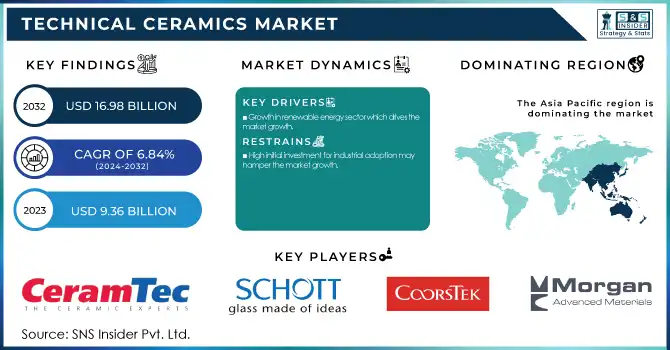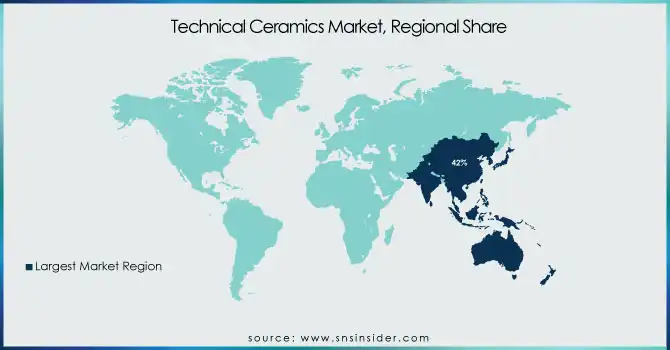Technical Ceramics Market Report Scope & Overview:
The Technical Ceramics Market size was USD 9.36 Billion in 2023 and is expected to reach USD 16.98 Billion by 2032 and grow at a CAGR of 6.84% over the forecast period of 2024-2032. The report provides the defined statistical assessment alongside the complete technical ceramics advertise components market plan. They provide in-depth market sizing, demand-supply gap and pricing trends analysis through their reports. In addition, the firm delivers competitive analysis, market share data and company profiles, based on strategies implemented by market leaders to expand their market footprint. In addition, it provides supply chain analysis and impact of government regulations, to develop a clear picture of industry trends and strategic positioning. With its data-driven methodology, the firm helps businesses assess potential for expansion, project industry trends, and deploy ways to compete in an increasingly changing space.

To get more information on Technical Ceramics Market - Request Free Sample Report
Technical Ceramics Market Dynamics:
Drivers
-
Growth in renewable energy sector which drives the market growth.
The renewable energy sector is another major factor contributing to the growth of the technical ceramics market, with significantly improving renewable energy efficiency and life. Technical ceramics like alumina, silicon carbide and aluminum nitride are used either alone or in combination in the manufacture of solar panels, wind turbines, hydrogen fuel cells, and battery storage systems, because these materials are extremely thermally stable, electrically insulative, and highly resistant to corrosion. Technical ceramics are used in solar energy applications to enhance the performance of photovoltaic cells and power conversion systems, leading to increased energy efficiency. In wind energy, ceramics can be used for turbine bearings and insulation systems where they resist temperatures and mechanical stress that would otherwise lead to costly maintenance, resulting in improved reliability. In addition, the rising utilization of hydrogen fuel cells, specifically within transportation and energy storage sectors, also multiply the demand for technical ceramics as these can also be used in solid oxide fuel cells, as well as, in electrolyzer cells for clean hydrogen generation. The global market is further driven by the investments made by Governments across the globe in renewable energy projects and clean energy infrastructure. The growing shift towards sustainable energy solutions across industries will provide significant opportunities for high strength technical ceramics, leading to innovation and growth in the market.
Restraint
-
High initial investment for industrial adoption may hamper the market growth.
Limitations in the technical ceramics market are the scale of initial capital investment required for industrial adoption of technical ceramics, as it involves the availability of advanced manufacturing technologies, precision machining, and specialized equipment for the production and integration of these materials. Compared to the metals and polymers, the technical ceramics are produced through complex processing steps, including several high-temperature sintering, advanced forming style and strict quality control, which lead to a higher production cost. An investment in bespoke machinery, R&D to optimize materials, and a skilled workforce training is needed for industries like automotive, aerospace, and electronics looking to incorporate technical ceramics in their components, thus raising the capital expenditures.
Opportunity
-
Growth in high-performance industrial equipment which create the opportunity in the market.
Increasing application of technical ceramics market for high-performance industrial equipment that requires survival in harsh environments creates an attractive technical ceramics market opportunity. Technical ceramics deliver excellent wear and corrosion resistance, coupled with high-temperature stability for demanding applications in industries like automotive, manufacturing, chemical processing, and heavy machinery. With industries always striving for better machinery performance and persistence, it leads to the necessity of components that are designed to work under extreme conditions, mainly cutting tool, industrial seals, bearings, and turbines. Technical ceramics such as silicon carbide, aluminium nitride, zirconate ceramics and others are essential in enhancing the life cycle and efficiency of such high-performance machinery. Manufacturers are adopting these advanced materials due to the continuous growth of industrial automation and the increasing demand for energy-efficient and sustainable machinery.
Challenges
-
High production complexity may create the challenge for the market.
One of the most serious challenges that the global technical ceramics market is facing is the higher production complexity associated with technical ceramics. Unlike other manufacturing processes, technical ceramics processing involves some specialized processes including high-temperature sintering, advanced machining, and precision forming, which are expensive in terms of time, labor, and high-end manufacturing equipment. While these processes provide the required properties to the ceramics in terms of strength, thermal stability, and electrical insulation, they also add to the overall cost of production, and the scalability of these processes becomes a challenge. Inevitably, even the tiniest changes in the production process can lead to defects due to the vast intricacies of production, thus leading to an increase in rejection rate, lower yield, etc.
Technical Ceramics Market Segmentation:
By Raw Material
Alumina ceramics held the largest market share around 38% in 2023. The major share of alumina ceramics in the overall technical ceramics market is due to their superior characteristics which make them applicable in various industries. Alumina (aluminum oxide, Al₂O₃) has outstanding hardness, and wear and thermal resistance and it is also a good electrical insulator, which makes it suitable for challenging applications. Common applications involve electronic components, automotive parts, aerospace components and medical devices, which need high-temperature, corrosion-resistant electrical insulators. Additionally, alumina ceramics are cheaper than many other high-performance ceramics and, therefore, are still among the most commonly applied materials in industry, especially in semiconductor, energy, and machine manufacturing sectors. Alumina ceramics can be customized by purity and microstructure to broaden the options for manufacturers to achieve particular performance specifications.
By Product
Monolithic ceramics held the largest market share around 68% in 2023. Monolithic ceramics dominated the technical ceramics market considering their versatile nature, high strength, and applications in a variety of industries. In these ceramics, a single, homogeneous material which possesses excellent mechanical properties high hardness, fracture toughness and thermal stability is used. Due to their stability under extreme environments such as elevated temperatures, corrosive environments and excellent wear resistance, they are considered to be valuable materials for aerospace, automotive, industrial machinery and energy applications.
By End Use Industry
Automotive held the largest market share around 28% in 2023. It is owing to the need for high performance and stringent conditions faced by modern vehicles. Technical ceramics are also widely used in automotive applications by several industries as they offer tremendous heat resistance, wear resistance and electrical insulation that make them ideal for a range of automotive components. Alumina, silicon carbide and zirconia ceramics have been widely used in some critical machinery parts (e.g. engine components, sensor, brake system, and catalytic converter) where safety, efficiency and durability are prerequisite. Increased penetration of electric vehicles (EVs), which need advanced ceramics in battery, power electronics, and thermal management package systems also fuel this trend.
Technical Ceramics Market Regional Analysis:
Asia Pacific held the largest market share around 42% in 2023. It is owing to significant presence across major consuming industries including electronics, automotive, aerospace, and energy, which makes vital use of technical ceramics. It is one of the fast-growing countries among China, Japan, South Korea, and India which drives QDA demand from the high-performance materials markets. Rapid industrialization in this region, along with investments in research and development (R&D) and advanced manufacturing technologies, has resulted in the deployment of technical ceramics in various sectors. For example, the substantial market growth in Asia-pacific is directly attributed to the regional dominance in the electronics and semiconductor industries, where the focused materials such as alumina ceramics and silicon carbide enjoy reaping benefits in several components such as insulators, capacitors, and substrates.
North America held the significant market share in market. It continuing initiatives focusing on improving energy efficiency and emission control in automotive and industrial areas are also accelerating the technical ceramics market growth. North American ceramic manufacturing infrastructure is particularly rich in innovations and sustainability in the development and manufacturing of advanced ceramic materials. In addition to this, initiatives and incentives from the government encouraging green technologies like renewable energy and electric vehicles provides a positive environment for the growth of the technical ceramics in the region, and is therefore fuelling the rapid growth of the market.

Get Customized Report as per Your Business Requirement - Enquiry Now
Key Players:
-
CeramTec GmbH – BIOLOX delta, Ceramaseal
-
Schott AG – ZERODUR, CERAN
-
CoorsTek, Inc. – CeraShield, CeraSurf-p
-
Morgan Advanced Materials plc – Haldenwanger, Diamonex
-
Carborundum Universal Limited (CUMI) – CUMI Electro Minerals, CUMI Industrial Ceramics
-
Kyocera Corporation – Fine Ceramics, Ceramic Knives
-
3M Company – Nextel™ Ceramic Fibers, 3M™ Silicon Nitride
-
Saint-Gobain Ceramics & Plastics, Inc. – Hexoloy, NorPro
-
NGK Insulators, Ltd. – Ceramic Substrates, NAS® Batteries
-
Corning Incorporated – Pyroceram, Corning Gorilla Glass
-
Murata Manufacturing Co., Ltd. – Multilayer Ceramic Capacitors (MLCCs), Ceramic Resonators
-
Rauschert GmbH – Technical Ceramics, Ceramic Filters
-
Superior Technical Ceramics Corp. – Ceramic Bearings, Ceramic Thermocouple Protection Tubes
-
McDanel Advanced Ceramic Technologies LLC – Alumina Tubes, Mullite Tubes
-
Ceradyne, Inc. (a 3M company) – Ceramic Armor Systems, Ceramic Orthodontic Brackets
-
H.C. Starck Ceramics GmbH – Silicon Carbide Components, Boron Carbide Components
-
Elan Technology – Technical Glass and Ceramics, Glass-Ceramic Seals
-
LSP Industrial Ceramics, Inc. – Ceramic Insulators, Ceramic Bushings
-
Advanced Ceramics Manufacturing – Ceramic Matrix Composites, Porous Ceramics
-
Blasch Precision Ceramics, Inc. – Ceramic Wear Liners, Ceramic Pump Components
Recent Development:
-
In 2024, CeramTec GmbH Expanded their range of ceramic hip joint components with advanced ceramic materials for enhanced wear resistance. This expansion helped the company to increase its production in the market.
-
In 2024, CoorsTek expanded its production capabilities for ceramic armor components, meeting increased demand from defense sectors.
-
In 2023, Schott AG developed a new glass-ceramic material for medical devices, improving biocompatibility and sterilization processes. This new product helped the company to increase its product portfolio in the market.
|
Report Attributes |
Details |
|---|---|
|
Market Size in 2023 |
USD 9.36 Billion |
|
Market Size by 2032 |
USD 16.98 Billion |
|
CAGR |
CAGR of 6.84% From 2024 to 2032 |
|
Base Year |
2023 |
|
Forecast Period |
2024-2032 |
|
Historical Data |
2020-2022 |
|
Report Scope & Coverage |
Market Size, Segments Analysis, Competitive Landscape, Regional Analysis, DROC & SWOT Analysis, Forecast Outlook |
|
Key Segments |
• By Raw Material (Alumina Ceramics, Titanate Ceramics, Zirconate Ceramics, Ferrite Ceramics, Aluminium Nitride, Silicon Carbide, Silicon Nitride) |
|
Regional Analysis/Coverage |
North America (US, Canada, Mexico), Europe (Eastern Europe [Poland, Romania, Hungary, Turkey, Rest of Eastern Europe] Western Europe] Germany, France, UK, Italy, Spain, Netherlands, Switzerland, Austria, Rest of Western Europe]), Asia Pacific (China, India, Japan, South Korea, Vietnam, Singapore, Australia, Rest of Asia Pacific), Middle East & Africa (Middle East [UAE, Egypt, Saudi Arabia, Qatar, Rest of Middle East], Africa [Nigeria, South Africa, Rest of Africa], Latin America (Brazil, Argentina, Colombia, Rest of Latin America) |
|
Company Profiles |
|

